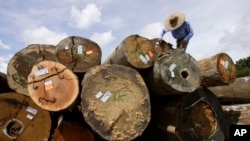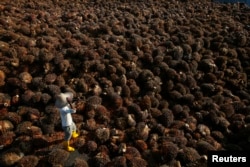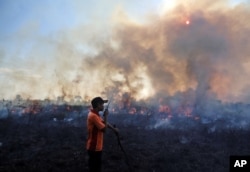Home to a dizzying array of endemic flora and fauna, Borneo’s rainforests are among the globe’s most precious.
And yet, no other tropical landscape is being lost as fast, with a third of the island’s old-growth forests – a chunk nearly the size of Syria – having been lost over the last four decades.
Many point to the expansion of industrial agriculture to explain the loss; in particular, the boom in palm oil plantations, which today cover some 10 percent of the island’s 74.3 million square hectares.
But a recent study published in Scientific Reports, which sets out to test this thesis, found that although the palm oil industry is a major driver of deforestation, location matters more.
Drawing on 40 years of satellite imagery, researchers concluded that while the palm oil industry was the top deforestation driver on the Malaysian side of the island (26 percent of the land mass), its role in deforestation on the Indonesian portion, also called Kalimantan (73 percent of the land mass), was less pronounced. (Brunei has the other 1 percent.)
Only in the last decade has industrial agriculture (pulpwood and palm oil) become the number one driver of forest clearance in Kalimantan, a finding researchers attribute to widespread use of “degraded land” for planting.
“Our study …clarifies that the role of oil-palm in deforestation is dependent not on the plant, but on where it is planted,” the study authors wrote.
“We are thus better able to assess whether industrial plantations are the cause or consequence of forest area loss in Borneo. Unsurprisingly, they are both, though the extent and contribution of each varies by country and period,” they added.
Planting on degraded land
To assess the true impact of industrial agricultural on deforestation, researchers examined the time-lag between clearing and planting.
They judged that if plantations were developed within five years of clearance, the owners were likely responsible. Longer delays, however, suggested natural or accidental clearing by fire, as the risk of leaving cleared land idle is known to be significant.
“Once land is deforested, it is likely to be taken by communities or by another company if it is not quickly developed,” lead study author David Gaveau told VOA.
“So companies usually do not clear forests long in advance if they do not quickly convert it to plantations or they will lose the land,” he added.
In Malaysia, deforested land was found to have been rapidly converted to plantations 57-60 percent of the time, while in Indonesia, the rate was just 15-16 percent.
The low rate in Indonesia, researchers reasoned, was due to the comparatively high availability of degraded forests, or shrublands, for planting. This they attribute to the twin effects of a dry climate and recurrent burning by subsistence farmers.
In modern Kalimantan, “forests have become disturbed by logging, conversion to plantations, etc., and these disturbed forests are now more prone to fires,” Gaveau explained.
“This permitted the development of some large-scale industrial plantations, without necessarily causing additional forest loss,” he wrote in the study.
Development in Malaysian Borneo, however, which contains some of the wettest rainforests on Earth, tells a different story.
“In Sarawak [one of two provinces in Malaysian Borneo], the climate is much too humid for fires ...in Sabah [the other province] the climate can be as dry as Kalimantan, but does not experience large fires,” Gaveau said. “This could be explained by more efficient no-fire practices, but we do not have proof.”
Shifting patterns
Despite its unexpected history of degraded land use, Kalimantan’s deforestation rate skyrocketed over the last 15 years. It was a trend that mirrored the growth of the industry as a whole.
Indeed, more than half of the current number of plantations in Borneo, island-wide, were established between 2005-2015 - and nearly 70 percent of that growth was in Kalimantan, where rapid conversion soared.
“Rapid, within-five-year, conversion in Indonesian Borneo increased from 7 percent in 1973–2000 to 51 percent in 2010–2015,” the study found.
According to Gaveau, Indonesia’s dream of becoming the world’s number one palm oil producer, as well as a 2005 economic boom, were major factors in the deforestation increase.
Herry Purnomo, a scientist at CIFOR, said the political economy of land burning was also a key influence.
To truly understand all the factors, he said, “We need to map the rate of deforestation with the political agenda. There is much evidence that fires and deforestation were connected to local elections, [when local heads] used land allocations/permits to attract voters.”
Even so, he said the study was valuable, and could help inform incentive schemes for no deforestation.
The research team is currently developing an online tool that would allow companies “doing the right thing” to avoid being lumped in with the firms still chopping down forests, Gaveau said.
Such a tool would enable better oversight by certification bodies like the Roundtable on Sustainable Palm Oil (RSPO) and, hopefully, help keep Borneo’s remaining forests in the ground.
“Planting on degraded lands is a cornerstone of sustainable development,” Gaveau said. “Our work reveals which firms…actively cleared forests, and which ones avoided deforestation by planting on degraded lands over the last four decades.”
“Right now REDD (reducing emissions from deforestation and degradation) is not really working, but our data sets a 42-year baseline for future effectiveness assessments.”









